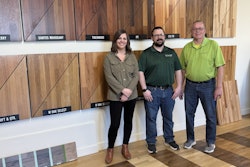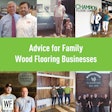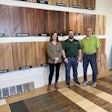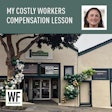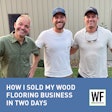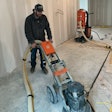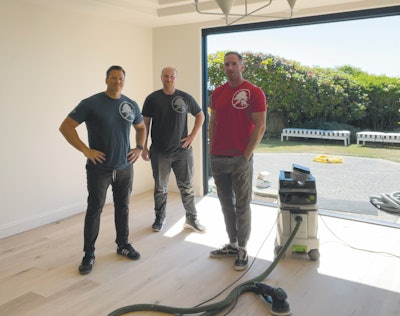
Many people will relate when I say that when I started in the wood flooring industry, it was a different world. I started right out of high school at 17 years old, and I wanted to make more money than I would in fast food. I had a buddy in hardwood flooring making double the minimum wage; all he told me was, “It’s hard work, but as long as you work hard, you’re going to make good money.” That’s all it took for me to apply. Now, as the owner of a wood flooring business, I can’t imagine someone doing what I did.
Back then in our Seattle market it was manual nailers, no dust containment and all high-VOC products. Hand-scraping and hand-sanding all the perimeters. Staining on our hands and knees. Coating on our hands and knees with a brush. It was oddly rewarding to work that hard, and up until a certain age, I craved it. But at the same time, a lot of tools were broken, the saws didn’t have guides or safety fences, and they had rusty blades. To say injuries were common is an understatement. Dust bags had holes and would blow dust everywhere because duct tape only goes so far! That dust was especially fun when prepping coats of poly or Swedish finish. Follow that up with dunking everything in lacquer thinner. Sometimes we would argue over who went in the house first, holding their breath to open up all the windows between coats. Basically by 18 years old I was surrounded by chemicals … a proud construction chemist who got stuck doing all the final coats because I was “good” at stretching the finish. On top of that, we were expected to install 300 square feet of oak strip a day. In case you think I’m talking about the distant past, this was 2001!
When I started my company in 2006, I knew that when I hired employees I didn’t want to treat them in a disrespectful way or have job sites like the ones I had worked on. Learning that way eventually crushes your spirit. It was just “get it done,” and that message was not always conveyed in, let’s say, a respectful manner. But that experience is what’s helping me realize what it takes to manage wood flooring employees in 2022. Here are some of the things I do to try to keep my small crews working and content with the demands of being a wood floor pro.
I pay competitively. In Seattle, you can get paid 30 bucks an hour just to deliver packages for Amazon, so my starting wage is in the high $20s and into the $30s. That’s just to get them to show up and do an easy version of Hardwood Floors with Kevin, not Hardcore Kevin from 20 years ago! Of course, I don’t want to be Hardcore Kevin anymore, either, which brings us to …
I’m careful about scheduling the workload. We are asking a lot of employees when we want them to work hard and work hard all day. I don’t think anyone wants to live that standard in construction anymore (I don’t) because it’s too hard on your body over time. So we have big days where we are doing demo or installation, we have medium days like sanding or coating only, and we have days where a guy is running errands to and from the supplier to job sites or is with me looking at jobs. It has to be a mix of all that now, or you run the risk of burning your employees out.
I offer benefits and paid time off. It used to be you could pay someone 20 bucks an hour and that was it—no paid time off, no benefits, no retirement plan. That was the threshold for good construction guys. Then it went up to $25 (still no benefits). It has completely changed over the last 10 years. You have to give people a job, not a week-to-week construction war zone. My guys have paid time off, paid holidays, multiple options for medical insurance and the option to participate in a 401(k). Multiple guys have newer vans they are able to use to drive to and from their homes to their jobs, and for guys without vans, I pay their gas money to and from jobs, because sitting in traffic is such a big expense here in Seattle.
They get sick time. I check in with the guys if they have a sniffle or cough or even a sore back: Are you feeling OK? Do you need a sick day? Here in Washington it’s the law that your workers earn sick time, so if they have the hours built up, that’s what they are there for. It does come at a cost, as the employers are covering the PTO, and it may affect the schedule on a given job, but these are the requirements these days.
I schedule jobs with a cushion. You don’t really have a choice: You have to cushion your jobs with a little extra time because people do need sick days, and they do take time off for smaller injuries. It’s part of being in business today. Also, our employees shouldn’t carry the stress of our business, so if the schedule gets tight and the job needs to get done, we need to jump in and do it or find another employee, not put all of that stress on our employees.
I’m careful about how I talk to the guys. I have always taken the approach of positivity over pressure and stress and anger toward them. I don’t raise a lot of issues with my guys, even when there are issues to be raised. I’m very careful, because you don’t want to offend people, and there might be other issues going on regarding why they are slacking. I find you have to be positive toward your employees and your customers in almost the exact same way. You have to treat people with a lot of care for them to stick around to do this kind of labor-intensive work.
RELATED: How We Hire and Keep a Motivated Workforce
I’ll always choose spending capital over doing something that’s more difficult. If you are willing to purchase better equipment, the progression the industry has made in the last 20 years is night and day. Honestly, to me it doesn’t matter if it’s $5,000, $10,000, a new van, whatever it is, I’ll buy it instead of us beating our heads against the wall and doing something in the most difficult fashion. For example, now we use Power Drives on every sand job, and that has helped the guys stay upright with less wear and tear on their bodies from a sanding machine pulling on their backs and their arms (of course, it helps the quality of our sand jobs, too).
I charge accordingly. To afford to do these things, you have to operate like a business, not just like a floor guy trying to buy a new boat. You need some sort of structure that ensures you’re going to make money on the job, otherwise the jobs aren’t worth doing. If you’re trying to give people a positive employment that requires a lot of labor, then you need to change in a way that enables your business to make money and afford those types of employees. As a floor guy you have to evolve: You have to be open to getting out of your comfort zone, representing yourself better than you think you could, and charging more than you think you can.
Health is wealth. People today want to protect themselves; they don’t want to touch stain without gloves, they don’t want to be around volatile organic compounds or have some sort of chemical sensitivity by the time they are 40 just because of their job. If you don’t have your health, what are you capable of?
One thing hasn’t changed in the last 20 years: Nothing feels better than a job well done. Creating a floor and seeing the final results is why we keep doing it. The more we can do it in a healthy way that’s easier on our bodies, with the right tools and processes, and in a more positive environment, the better it will be for the future of our industry.















